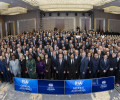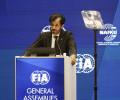AUTO - PROTECT AND PRESERVE

Since its foundation in 1904, the FIA has followed and helped influence the development of the automobile in all its road and racing forms. Tasked with celebrating that incredible history, the Federation’s Founding Members Club each year awards the FIA Heritage Cup to events and individuals displaying an exemplary passion for the preservation of motoring’s rich record.
At the end of the second decade of the 21st century, the automobile stands at a crossroads. The world of mobility is changing with stunning rapidity as alternative energies affect the nature of the vehicles we drive – and as the development of autonomous vehicles calls into question the very need to drive at all.
And as the automobile, or whatever it might one day become, continues its relentless forward march, left behind in our desire to construct a better, brighter, more technologically advanced future is over a century of incredibly rich motoring heritage.
Weighed down by the opprobrium being heaped upon the internal combustion engine due to its environmental legacy, and dismissed as the pastime of either moneyed dilettantes or fusty enthusiasts, the history of the automobile as societal game-changer, technical marvel and object of desire is in danger of being subsumed by the very desire the car first engendered – to keep moving forward.
In order to raise awareness of the deep history that exists within the Federation and to celebrate the preservation of automotive heritage, the FIA turned to its Founding Members’ Club (FMC).
As the name suggests, the club harks back to the origins of the FIA and the early years of the automobile’s rise to dominance.
As interest in motoring grew, the natural extension of that passion was racing and at the start of the 20th century one of the major motor sport events was the Gordon Bennett Cup.
Instituted by the millionaire owner of the New York Herald newspaper and administered by the Automobile Club de France (ACF), the Cup was awarded at the end of long races, often city-to-city events, contested by entries from a variety of national motoring associations.
Hugely successful, the races drew large entries and enormous crowds of spectators, and by 1904 required more formalisation and regulation. At the Gordon Bennett race in Bad Homburg, Germany the members representing the race’s competing national motoring organisations met to form an international federation of motoring club, which became known as the Association Internationale des Automobiles-Clubs Reconnus (AIACR), the body that eventually became the FIA.
CELEBRATING HISTORY
More than a century later, the 13 clubs (or their successors) from Austria, Belgium, Denmark, France, Germany, Great Britain, Holland, Italy, Portugal, Russia, Spain, Switzerland and the USA that came together in Bad Homburg constitute the members of the FMC, with the club’s primary goal being the preservation of automotive heritage.
“In a world where we are constantly talking about change, about the arrival of increasing hybridisation and the rise of autonomous cars, it is incredibly important to celebrate where we came from, to properly mark the evolution of the automobile, its pioneers and to keep alive the historic vehicles still in existence,” says FMC President Carlos Barbosa, also President of the Automóvel Club de Portugal (ACP).
“In today’s automobile world it is justifiable and important to look at heritage and the history of the car,” adds FMC Vice-President Franz Graf zu Ortenburg, also Vice-President of Germany’s Automobilclub von Deutschland e V (AvD).
“If you walk around any city the automobile is so dominant and it has utterly defined the shape of the landscape. The automobile has changed the way we live and if you look at it from that angle alone – as well as the engineering and technical point of view, the design element – then it is so important to recognise the automobile’s influence and its impact on society, and the people who made it so.”
To advance that cause the club each year awards The FIA Heritage Cup. Presented at the Federation’s December Prize Giving ceremony, the cup is a special award designed to celebrate the efforts of committed organisations, events and individuals to promote and preserve the history of the automobile. Submissions for the prize are solicited from the FIA community around the world, with applications being judged by the panel of FMC members.
“The Cup is the Founding Members’ Club’s opportunity to get something that we believe in to the top of the agenda at one of the FIA’s biggest events – the FIA Prize Giving,” says Peter Read, Board Member and Chairman of the Motoring Committee of Britain’s Royal Automobile Club.
“If we have a heritage award at that prize giving, it suddenly gives great visibility to the automotive history, and everyone exposed to the media surrounding the event understands that there is
more to the FIA than just Formula 1. There is a huge world of automotive activity which celebrates past ages of motoring and it’s highly important for us to have that platform.
“In choosing the award recipient we need to ensure that it is significant in terms of preserving historic vehicles and what they stand for. It needs to be international. It needs to be inclusive and it should also have a great story to tell.”
Launched in 2010, the Cup was first awarded to Britain’s iconic London to Brighton Veteran Car Run and in the years since has been given to the Netherlands’ Louwman Museum of classic cars in 2011, the reborn Mille Miglia (2012), the AvD’s Oldtimer Grand Prix event (2014), the RAC’s 1000 Mile Trial (2015) and the Targa Florio (2016).
Last year, the award was handed to the Sports Car Racing Association of the Monterey Peninsula for the Rolex Monterey Motorsports Reunion held at Laguna Seca circuit.
An annual four-day celebration of incredible motor sport machinery from the past and the legends that raced them, the Monterey event now regularly features more than 550 historic cars in 15 different categories doing what they were designed to do – race.
The RAC’s Peter Read says the Monterey event is a perfect example of the symbiotic relationship between prize and award winner.
“There is a two-way benefit to the FIA Heritage Cup,” he explains. “Being presented at the FIA Prize Giving, the award gives the winner publicity and then, as it comes from such a large and globally recognised motoring and motor sport authority, the Cup winner can use the validity the award gives to promote their event or activity.
“In the case of Monterey, the award was quite important for them because it was the first time that the trophy had gone to the US. Indeed, when we went to Laguna Seca this year, there was the trophy right in the middle of the drivers’ lounge, on display to show how important it was.
“It was a similar case with a special commendation we gave to Brooklands last year,” Read adds. “We knew they intended to use the FIA logo for their marketing purposes to try to drive attendance at Brooklands and that’s exactly what we are trying to do with the Heritage Cup – drive people to experience heritage. Providing Brooklands with the publicity opportunity via the commendation and providing something akin to a seal of approval from the FIA will we hope encourage that connection with our heritage.”
The FMC’s desire for submissions to tell a good story is reflected in the 2018 Cup winner – the HTL Steyr Higher Technical Institute from the town of Steyr in Austria.
Nominated by FMC member club the ÖAMTC, the college was awarded the Cup for the painstaking construction by its mechanical engineering students of an exact replica of the Second Marcus car.
Not surprisingly, Siegfried Marcus’ is a name that will not be instantly familiar. One of the pioneers of automobile design, Marcus has largely been overshadowed by the prominence given to greats such as compatriots Gottlieb Daimler and Karl Benz.
Marcus, though, can lay claim to being one of the very first men to build what we understand to be an automobile.
A LEGACY REBORN
After moving to Vienna from his native Germany in 1852, Marcus began developing telegraphic machinery and ignition devices before turning his attention to engines. It is believed that sometime between 1864 and 1875, he became the first inventor to gear a combustion engine to a set
of four wheels, in the form of a simple handcart, some 10-15 years before Daimler and Benz’s more celebrated achievements.
After his initial efforts Marcus constructed a second, much more advanced vehicle in 1888-89. The Second Marcus Car has all the features of the modern automobile, including steering and brakes, a high-speed four-stroke petrol engine (single-cylinder) with spray brush carburettor and magnetic breakaway ignition. It is this car, owned since 1898 by the ÖAMTC and permanently housed in the Vienna Technical Museum, that the HTL Steyr students sought to recreate.
Explaining the origins of the Austrian club’s nomination of the project, Georg Brown, Head of the Classic Car Department at the ÖAMTC, explains: “In 2001, the Austrian Federal Office for the Preservation of Historical Monuments listed the Second Marcus Car as ‘the oldest petrol car in the world to have survived in its original state’. From our point of view, the project to replicate the car by students contributed significantly to inspiring young people to discover the origins of historical mobility and to preserve the associated technical know-how for future generations.
“The spirit of the project embodies the objectives of the FIA Heritage Cup,” he adds. “Receiving the award is a big recognition not only for the project carried out by HTL Steyr, but also for the significant contribution of Siegfried Marcus.”
Beginning in 2004, the project was laboured over by a total of 118 students for some 20,000 working hours, with close attention being paid to every detail of the car’s design and build.
“The aim was to prove that the car can be operated, even in the cold of winter time,” says Dr Franz Reithuber, Director of HTL Steyr. “Beside the 3D-Laser measurements, which were done at the technical museum in Vienna, all other design, calculation and production work was done in the shops and laboratories of the school. Only casting and the production of the wheels were done outside at partner companies.”
The manufacture of the car’s wooden wheels proved to be one of the trickiest aspects of the project. “Knowledge of how to produce wooden wheels in the traditional way hasn’t been necessary for many decades, so it was hard to find anyone still able to do that. Luckily we found a very senior gentleman who was able to help us in that area. It was similarly complicated to find anyone who knew how to produce the leather straps for the powertrain.”
The painstaking replication of Marcus’ remarkable invention finally reached completion in 2016, and the students’ efforts were rewarded in April of that year when the then-Austrian Federal President Dr Heinz Fischer completed the first trip in the car. The project was equally commended by then-President of the ÖAMTC Werner Kraus.
The recreation of the Second Marcus, the inspiration it provided to young people engaged in the project and the contribution that the replica makes to the greater understanding of the earliest history of automobile development, made HTL Steyr’s project a fitting recipient for the 2018 Heritage Cup, says FMC President Barbosa. “The story of the Marcus Car and the 12-year project of the HTL Steyr students is simply amazing. To rebuild this incredible machine and shine a light on its inventor is what the Heritage Cup is about.”
With the 2018 prize awarded, the FMC’s attention now turns to soliciting submissions for the 2019 prize. It is, says Graf zu Ortenberg, not an easy task. “The Heritage Cup is still relatively unknown,” he explains, “so we want to encourage everyone from the FIA network to consider making a submission if there is an event, project or person they deem worthy of recognition. The Founding Members’ Club exists to preserve our heritage and reward those most involved in that process. The automobile has been part of society for 120 years and deserves to be recognised, protected and most of all celebrated, and the FIA Heritage Cup is our way of doing that.”

 Facebook
Facebook Twitter
Twitter






